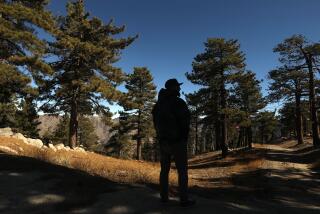Preservation, not profit, takes precedence at Big Horn Mine in the San Gabriels
Reporting from Wrightwood, Calif. — The Big Horn Mine, perched on a mountainside overlooking the headwaters of the San Gabriel River, still holds an estimated 262,000 ounces of gold in its quartz bedrock. At current prices, that haul would be worth more than $430 million.
The wild country surrounding the mine, framed by alpine peaks and watered by snowmelt running through wrinkled canyons and ancient pine forests, is a refuge for bears, mountain lions and endangered Nelson’s bighorn sheep.
Within a few days, preservation will trump economics when the 277-acre parcel is handed over to the public.
The transfer of title to the U.S. Forest Service will cap six years of arduous negotiations by the nonprofit Wilderness Land Trust, which acquires unprotected private land and returns it to the people. And, trust president Reid Haughey reported with a hint of satisfaction, taxpayers got this slice of paradise for a bargain price: $2 million.
“At 277 acres, this is a relatively small transaction,” he said, standing knee-deep in sage and prickly yuccas on a promontory near the mine’s long-abandoned ore mill. “But the value of adding it to the surrounding wilderness for future generations is significant.”
The mine on the eastern flank of 9,399-foot Mt. Baden-Powell was first prospected in 1859. In its heyday in the 1930s, Big Horn Mine supported a community of cabins, machine shops and a post office serving the 30 workers who operated its steam-powered rock crushers and trucked ore down the mountain for processing.
Permits to mine gold were valid until just a few years before the land trust — with $125,000 in private donations and a long-term loan of $825,000 — bought the property from a private mining company in 2007. It was ultimately sold to the Forest Service for $2 million.
“We moved quickly to prevent the land from being marketed for its mineral resources and potential as a mountain retreat,” Haughey said. “When we bought the mine, gold was selling for $350 an ounce. Today, it sells for about five times that much.”
Negotiations with federal officials got off to a shaky start, Haughey said, when they balked at accepting liability for the rusting mill or the mine shaft — roughly 350 yards deep and 8 feet wide — which they wanted to seal with foam. Instead, a steel gate was installed to prohibit public access to the mine, which bats use as habitat.
Eventually, the Forest Service agreed to protect the relics on the property that Angeles National Forest Supervisor Tom Contreras described as “a great contribution to the wilderness and important reminder of Southern California’s pioneers.”
The trust also recently completed a complex deal that resulted in the donation of a 2,450-acre, 100-year-old gypsum mine just south of Death Valley National Park to the U.S. Bureau of Land Management.
Avawatz Salt and Gypsum Co. was established in 1912 to supply cement and sheetrock for one of Southern California’s first building booms. The company spent huge sums on engineering reports, soil samples and surveys for its mining operations, and on plans for a railroad. But after World War I began, the firm was unable to secure financing for its ambitious projects.
The mine operated for only a few years and never turned a profit.
Acquiring the arid landscape of craggy peaks and salt flats for preservation presented an unusual problem: how to buy a company in which many of the shareholders were deceased or all but impossible to find.
The solution involved creating an entity called Avawatz Acquisition Corp., then merging it with the mining company, said land trust treasurer Jim Blomquist. The trust, as the main shareholder in the new corporation, directed it to donate the property to the BLM.
“We made about $2 on that particular deal,” Blomquist said with a laugh.
More to Read
Sign up for Essential California
The most important California stories and recommendations in your inbox every morning.
You may occasionally receive promotional content from the Los Angeles Times.











